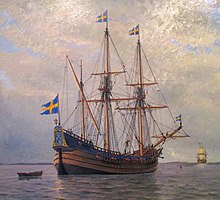Kalmar Nyckel

Calmare Nyckel oil painting by Jacob Hägg, 1922
|
|
| History | |
|---|---|
|
|
|
| Name: | Kalmar Nyckel |
| Owner: | The Ship Company (Skeppskompaniet) |
| Route: | Gothenburg, Sweden — New Sweden, North America |
| Launched: | c. 1625 |
| Acquired: | 1629 |
| Status: | Sold to Swedish Navy, 1644 |
| Commissioned: | 1644 |
| Decommissioned: | June 19, 1651 |
| Fate: |
|
| General characteristics | |
| Type: | Pinnace |
| Sail plan: | Full-rigged ship |
| Crew: | 40 sailors & 28 soldiers (in Naval service) |
| Armament: |
|

The Kalmar Nyckel leaves Lewes, Delaware, for an evening cruise
|
|
|
|
|
|---|---|
| Name: | Kalmar Nyckel |
| Owner: | Kalmar Nyckel Foundation |
| Port of registry: | Wilmington, Delaware |
| Builder: | Allen Rawl, Wilmington, Delaware |
| Launched: | September 28, 1997 |
| In service: | May 9, 1998 |
| Identification: |
|
| Status: | in active service, as of 2012[update] |
| General characteristics | |
| Displacement: | 298 long tons (303 t) |
| Length: |
|
| Beam: | 25 ft (7.6 m) |
| Height: | 105 ft (32 m) |
| Draft: | 12 ft 5 in (3.78 m) |
| Propulsion: | 2 × 180 hp (134 kW) Caterpillar 3208 diesel engines |
| Sail plan: |
|
| Speed: | |
| Endurance: | 6 days |
| Capacity: | 49 passengers |
| Crew: | 24 |
The Kalmar Nyckel (Key of Kalmar) was a Dutch-built armed merchant ship famed for carrying Swedish settlers to North America in 1638 to establish the colony of New Sweden. A replica of the ship was launched at Wilmington, Delaware, in 1997.
The Kalmar Nyckel was constructed in about 1625 and was of a design called a pinnace. The ship was originally named Sleutel (Dutch for key), and to distinguish it from several other ships called Key it was known by the name of the city of Kalmar, which purchased the ship in 1629 as its contribution to a state-sponsored trading company, Skeppskompaniet. It was later purchased into the Swedish Navy. When Sweden decided to establish a trading colony in the New World under the direction of Peter Minuit, the Kalmar Nyckel was chosen for the voyage. A smaller vessel, the Fogel Grip (Griffin Bird), accompanied her.
The ships sailed from Gothenburg in December 1637, commanded by Jan Hindriksen van der Water, but encountered a severe storm in the North Sea and had to divert to the Netherlands for repairs. They departed on New Year's Day 1638, arriving in North America in March 1638. They built a fort on the present site of the city of Wilmington, which they named Fort Christina.
A second voyage, which departed on February 7, 1640, and arrived at Fort Christina on April 17, brought additional settlers for New Sweden. One of them was Reorus Torkillus, the first Lutheran clergyman in New Sweden. The Kalmar Nyckel made four successful round trips from Sweden to North America, a record unchallenged by any other colonial vessel.
Between colonial voyages, the ship was used by the navy as a transport and courier. She was sold out of Swedish service to Dutch merchants in 1651. At the outbreak of the First Anglo-Dutch War, she was employed as a fisheries protection vessel under Captain Dirk Vijgh. The ship was sunk off the coast of Scotland in action against Blake's squadron on July 12, 1652.
...
Wikipedia
